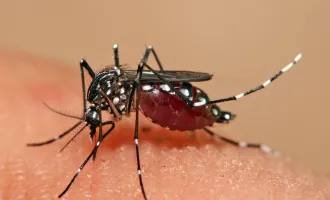Ishi: The Greatest Anthropological Treasure
In 1999, the UCSF Synapse published a short article about the continued efforts to repatriate the remains of Ishi, who spent the last years of his life on the Parnassus campus before dying in 1916. Fifteen years later, in time for UCSF’s sesquicentennial, we offer a long-due conclusion to Ishi’s story.
One hundred years ago, before UCSF became a global brand in the health sciences, Parnassus Avenue was home to the Affiliated Colleges of the University of California. Riding a streetcar toward the ocean, one would first pass the College of Dentistry and Pharmacy, then the Romanesque stone façade of the College of Medicine and finally, most curiously, the University Museum of Anthropology.
In 1914, this anthropology museum, originally intended for the Hastings College of the Law, housed artifacts from the Phoebe Hearst Collection—Greek coins, Egyptian mummies and the like. Among these curios, bought or plundered from cultures long since extinct, lived an assistant janitor known as Ishi, a man whom the San Francisco Examiner called “the greatest anthropological treasure…ever captured.”
I
The story of Ishi and his tribe stretches back centuries before his time at the Affiliated Colleges, a long thread in the history of indigenous Californians cut short by settlers and disease. Suffice to say, by the time a worn and hungry stranger appeared in late August at a slaughterhouse in Oroville, a town some 70 miles north of Sacramento, the butchers initially thought the darker-toned man was Mexican.
The news from Oroville attracted the attention of UC Berkeley anthropologists Alfred Kroeber and Thomas Waterman, who had been studying the indigenous peoples of California. Waterman traveled to Oroville to bring the man back to San Francisco for further study, and a residence was arranged for him in early September of 1911 at the Museum of Anthropology on Parnassus Avenue.
As was customary among the Californian tribes, the man was reticent to share his name with strangers. Kroeber eventually settled on Ishi, an Anglicization of the word for “man” in the Native American’s language. The Berkeley anthropologists decided that Ishi’s language was a distinct dialect of Yana, a language spoken by a group of indigenous peoples in Northern California. Kroebler and Waterman named this dialect “Yahi,” based on yaaxi, Ishi’s word for “the people.”
II
For the next several years, Ishi would share his language and culture not only with the Berkeley anthropologists, but also with the throngs of curious visitors to his museum home, demonstrating his skills in archery, fire-making and arrowhead chipping. In the first six months of his arrival, thousands visited the museum to see this “living artifact.”
During his time at the Affiliated Colleges, Ishi became acquainted with Saxton Pope, a University of California surgeon who became Ishi’s personal physician and archery companion. The two could be seen shooting targets together in Golden Gate Park.
Pope would later recall Ishi’s involvement with the University hospital: “he quietly helped the nurses clean instruments or amused the interns and nurses by singing his Indian songs…His affability and pleasant disposition made him a universal favorite.”
Given his immune system’s limited experience with the deadly communicable diseases of the day, Ishi’s contact with the sick, both at University Hospital as well as at his museum home, put him at high risk for infection. Indeed, Ishi was initially hospitalized with chills and fever when he came to San Francisco, but he recovered and gained back the weight he lost.
According to Pope’s notes, Ishi’s final sickness began in the summer of 1915, presenting with symptoms consistent with tuberculosis. Throughout the next few months, Pope noted Ishi’s cough, painful abdomen with signs of pyloric obstruction and inability to tolerate food and water. Finally, Ishi was hospitalized in March of 1916, where he suffered a large pulmonary hemorrhage.
Pope administered a large dose of morphine before Ishi died at 12:20 p.m., March 25, 1916.
III
Prior to Ishi’s death, Kroeber, who was on sabbatical at the time, learned of Dr. Pope’s plans to perform an autopsy on Ishi’s body. Kroeber urgently wrote to a colleague instructing him to stop the proceedings: “I might be willing to consent if it were to be a strict autopsy in the ordinary sense to determine the cause of death, but as they know that, I suspect that the autopsy would resolve itself into a general dissection. Please shut down on it.”
The anthropologist continues more colorfully: “If there is any talk about the interests of science, say for me that science can go to hell. We propose to stand by our friends.”
Kroeber’s colleague regretfully wrote in response that his instructions came too late. Pope had a pathologist colleague at the University Hospital conduct the autopsy.
It was also noted in this letter that Ishi’s brain was preserved, and that the man was cremated according to his wishes along with: “one of his bows, five steel pointed arrows, a basket of acorn meal, ten pieces of dentalium, a box full of shell bead money which he saved, a purse full of tobacco, three rings, and some obsidian flakes.”
Missing from this account, and indeed nearly all other contemporaneous accounts of Ishi’s passing, was any indication of what happened to Ishi’s brain. Was it returned and cremated along with Ishi’s body? Or did “preserved” signify something more unsettling, a hint that even in death, Ishi would endure as an object of scientific inquiry?
IV
The questions around the whereabouts of Ishi’s brain were not simply academic—in 1997, the Butte County Native American Cultural Committee, chaired by Arthur Angle of the Maidu people, began a campaign to locate and repatriate Ishi’s remains to his original home.
Ishi’s ashes could still be found in an inscribed pot housed in the Olivet Cemetery in Colma, Calif. But no confirmation could be found as to the whereabouts of Ishi’s brain. Finally, after more than one year of investigations, efforts by UCSF historian Nancy Rockafeller and Duke University anthropologist Orin Starn led to the discovery of a letter, filed away in the archives of UC Berkley’s Bancroft Library, confirming that Kroeber had Ishi’s brain shipped to the National Museum in Washington, DC.
In January of 1999, Starn personally met with Thomas Killian of the Smithsonian Repatriation Office, who confirmed that Ishi’s brain was being housed in a storage facility in Maryland. A few months later, a delegation of Maidu from Butte County traveled to the Smithsonian to meet with Killian and perform a purification ceremony for Ishi’s brain.
Starn, who was invited by the Maidu, would later recall seeing the preserved brain in that DC conference room, “I felt the moment’s power, too. Reading the letters and doing the research was one thing; to be confronted with the thing itself was something else again.”
Ishi’s brain had finally been accounted for, but the process for returning it to California for reburial would prove to involve its own challenges. According to Smithsonian policy, remains were first repatriated to direct descendants and then to the tribal group as a whole. Even though there were no known Yahi survivors at the time, the Smithsonian announced that the Butte County delegation had no cultural affiliation with Ishi and the institution planned to launch an investigation to determine Ishi’s closest living relatives.
The months following the Maidu’s trip to Washington was marked by testy public statements and recriminations that left the fate of Ishi’s brain in doubt. Finally, in May of 1999, the Smithsonian announced that Ishi’s remains would be repatriated to the people of the Redding Rancheria and Pit River Tribe, which were believed to be descendants of the Yana and other neighboring indigenous groups.
In early August of 2000, 84 years after his first burial, Ishi’s remains—his ashes and his brain—were buried in a private ceremony somewhere in the foothills of Mount Lassen, 70 miles east of Redding, Calif. One month later, members of various indigenous tribes of Northern Californian, along with Tom Killian of the Smithsonian, UCSF’s Nancy Rockafeller and Duke’s Orin Starn, gathered in a meadow in Mount Lassen National Park to celebrate Ishi’s repatriation.
In an interview with the UCSF Center for Health and Community not long after the ceremony, Rockafeller would state, “And now Ishi has come home to a very vibrant world of traditions and honors.”
***
This year, as UCSF celebrates its sesquicentennial, the University is rolling out a number of events and exhibits to proudly showcase 150 years of its contributions to our city, our state and our nation. And rightly so. From humble beginnings as a provincial medical college, UCSF has emerged as one of the world’s premier brands in medicine and the biomedical science.
However, as we look ahead with anticipation to the next 150 years of “advancing health worldwide,” we must not forget some uncomfortable truths about our institution’s past. Although Ishi’s time at the Affiliated Colleges was brief, his life, his death and his subsequent rebirth as a symbol of Native repatriation are entangled within our nation’s long history of abusing indigenous peoples and cultures, not to mention our profession’s even longer history of well-intentioned hubris.
In concluding her report on the investigation to locate Ishi’s brain, Rockafeller wrote, “All participants in academic life must recall the historical context of individuals like Pope, Kroeber, and Waterman—and remember that the source of their conviction that they were ‘doing the right thing’ was the scientific certainty of the day.”
“We, in turn, must recognize that a sense of moral discomfort is perhaps a better indicator for action than scientific curiosity.”
For a more expansive story of the journey to return Ishi’s remains, see Orin Starn’s excellent book, “Ishi’s Brain.” Letters and newspaper articles concerning Ishi can be found in “Ishi the Last Yahi,” edited by Robert Heizer and Theodora Kroeber. A chronology of Ishi’s life and death written by Nancy Rockafeller can be found in the “Special Topics” section of the History of UCSF website (http://history.library.ucsf.edu/index.html).
Special thanks to Margaret Hughes from the UCSF Archives and Special Collections for the images reprinted in this article.


